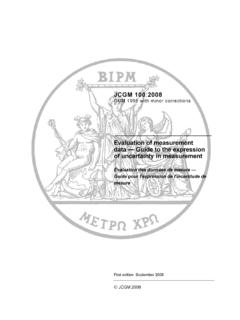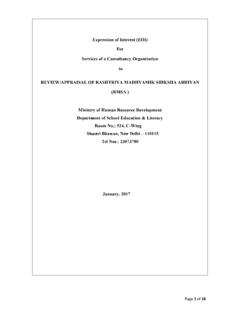Transcription of Risk Communication Applied to Food Safety …
1 RISK Communication Applied TO food SAFETYHANDBOOKFOOD Safety AND QUALITY SERIES 2 ISSN 2415-1173 For further information on the joint FAO/WHO activities on food Safety , please contact:OFFICE OF food SAFETYAGRICULTURE AND CONSUMER PROTECTION DEPARTMENTFOOD AND AGRICULTURE ORGANIZATION OF THE UNITED NATIONSV iale Terme di Caracalla00153 - Rome, ItalyE-mail: OF food Safety AND ZOONOSESWORLD HEALTH ORGANIZATIONCh-1211 Geneva 27 SwitzerlandE-mail: photos (from left to right): WHO/Francoise Fontannaz; FAO/J. ThompsonFOOD AND AGRICULTURE ORGANIZATION OF THE UNITED NATIONSWORLD HEALTH ORGANIZATIONROME, 2016 RISK Communication Applied TO food SAFETYHANDBOOKThe designations employed and the presentation of material in this publication do not imply the expression of any opinion whatsoever on the part of the food and Agriculture Organization of the United Nations (FAO) or of the World Health Organization (WHO) concerning the legal status of any country, territory, city or area or of its authorities, or concerning the delimitation of its frontiers or boundaries.
2 Dotted lines on maps represent approximate border lines for which there may not yet be full agreement. The mention of specific companies or products of manufacturers, whether or not these have been patented, does not imply that these are or have been endorsed or recommended by FAO or WHO in preference to others of a similar nature that are not mentioned. Errors and omissions excepted, the names of proprietary products are distinguished by initial capital letters. All reasonable precautions have been taken by FAO and WHO to verify the information contained in this publication. However, the published material is being distributed without warranty of any kind, either expressed or implied. The responsibility for the interpretation and use of the material lies with the reader. In no event shall FAO and WHO be liable for damages arising from its use. The views expressed herein are those of the authors and do not necessarily represent those of FAO or WHO.
3 WHO Library Cataloguing-in-Publication DataRisk Communication Applied to food Safety : handbook.( food Safety and quality series, 2) Safety . Management. Contamination - prevention and control. Assessment - methods. Health Organization. and Agriculture Organization of the United Nations. ISBN 978 92 4 154944 8 (WHO) (NLM classification: WA 701)ISBN 978-92-5-109313-9 (FAO)ISSN 2415-1173 FAO and WHO, 2016 FAO and WHO encourage the use, reproduction and dissemination of material in this information product. Except where otherwise indicated, material may be copied, downloaded and printed for private study, research and teaching purposes, provided that appropriate acknowledgement of FAO and WHO as the source and copyright holder is given and that FAO and WHO s endorsement of users views, products or services is not implied in any requests for translation and adaptation rights, and for resale and other commercial use rights should be made via or addressed to FAO information products are available on the FAO website ( ) and can be purchased through Communication Applied TO food Safety HANDBOOKCHAPTER 1 WHAT IS food Safety RISK Communication , AND WHY IS IT IMPORTANT.
4 What is food Safety risk Communication ? .. Why is food Safety risk Communication important? .. The goals of food Safety risk Communication .. Challenges to effective risk Communication .. Why is risk perception important? .. Use of food Safety risk Stakeholders and target audiences ..17 Key references ..19 CHAPTER 2 PRINCIPLES OF GOOD RISK Communication .. Trust in information and regulatory institutions .. Principles of good food Safety risk Communication .. Openness and transparency .. Timeliness and responsiveness .. The importance of planning ..28 Key references ..32 TABLE OF CONTENTSList of figures ..vAcknowledgements ..viList of abbreviations ..viiINTRODUCTION AND PURPOSE ..1 Background ..1 Rationale for developing this handbook ..2 Purpose and target audience ..2 Scope ..3 Method ..3 Format and how to use the handbook ..3 References ..5ivRISK Communication Applied TO food Safety HANDBOOKCHAPTER 3 KEY FACTORS TO CONSIDER BEFORE COMMUNICATING ABOUT food Safety risks .
5 Understanding the nature of the food Safety issue .. What is the nature of the risks and benefits involved? .. What is the nature of the hazard? .. Assessing the quality/certainty of the available data .. Understanding what can be done about the risk .. Anticipating and addressing unintended consequences .. Understanding target audience needs .. The cultural and socio-economic background of target audiences .. How to reach target audiences .. What is the history of the risk, and the political and media environments surrounding it?.. Understanding the communicator s responsibilities for food Safety risk Communication ..49 Key references ..53 CHAPTER 4 PUTTING food Safety RISK Communication INTO ACTION .. Knowing the target audience .. How to understand target audiences .. Stakeholder interactions .. Dealing with uncertainty .. Message development .. Choosing Communication channels/tools/methods .. Interacting with the media.
6 Interacting with other countries and beyond .. Monitoring and evaluation ..73 Key references ..76 APPENDICES SUPPLEMENTARY MATERIAL ..77 Appendix 1: Rapid assessment of risk Communication capacity ..78 Appendix 2: Risk perception assessment tool ..81 Appendix 3: Accessible writing low literacy guidelines ..82 Further reading ..83 Web sites with relevant training materials ..84 Glossary ..85vRISK Communication Applied TO food Safety HANDBOOKLIST OF FIGURESF igure Components of risk analysis ..8 Figure Tailoring food Safety information to different target audiences ..45 Figure Example of a good use of visual material for effective Communication of food Safety risk Communication Applied TO food Safety HANDBOOKACKNOWLEDGEMENTSFAO/WHO is grateful to the international food Safety risk Communication specialists who participated in the handbook drafting workshop held in Rome in October 2013, and who reviewed follow-up drafts of the handbook, namely Ryan Baker (Health Canada, Canada), Andrew P.
7 Benson (International food Information Council and Foundation, USA), Lynn J. Frewer (Newcastle University, UK), Barbara Gallani ( food and Drink Federation, UK), William Hallman (Rutgers University, USA), Eunsook Moon (Korea food and Drug Administration, Korea), Rose Omari (Science and Technology Policy Research Institute [STEPRI-CSIR]/EATSAFE, Ghana), Amy Philpott (Watson Green LLC, USA) and Laura Smiley (European food Safety Authority, Italy). FAO/WHO is also grateful to specialists who contributed to the provision of feedback during the handbook pre-testing at the FAO/WHO Regional Europe and Central Asia Workshop on Risk Communication Capability Building in food Safety held in Budapest in June 2015, namely Melinda Frost (WHO/International consultant) and Shira Tabachnikoff (European food Safety Authority, Italy).The document was also peer-reviewed by Sharon Natanblut ( food and Drug Administration, USA), Laura Smiley (European food Safety Authority, Italy) and Ian Young (University of Guelph, Canada).
8 FAO/WHO would like to express appreciation to the United States food and Drug Administration for partial funding of this project under the project ID. GCP /GLO/443 would like to express gratitude and appreciation to the many people who provided advice and guidance during the drafting and pre-testing of this handbook. The drafting and pre-testing of the handbook was coordinated by Andrijana Rajic (FAO) in collaboration with Heleen van Dijk ( food Risk Communication /International consultant, the Netherlands), Caroline Merten (FAO), Eleonora Dupouy (FAO), Francoise Fontannaz-Aujoulat and Mina Kojima (WHO). viiRISK Communication Applied TO food Safety HANDBOOKLIST OF ABBREVIATIONSBPAB isphenol ACACC odex Alimentarius Commission E. coliEscherichia coliEFSAE uropean food Safety AuthorityFAOFood and Agriculture OrganizationFDAU nited States food and Drug AdministrationGMOG enetically modified organismGMPGood manufacturing practiceINFOSANI nternational food Safety Authorities Network LFTBLean finely textured beefNGONon-governmental organizationWHOW orld Health OrganizationPHACP ublic Health Agency of Canada WHO/Sergey Volkov1 BACKGROUNDRisk Communication is defined as the exchange of information and opinions concerning risk and risk-related factors among risk assessors, risk managers, consumers and other interested parties (FAO/WHO, 1998).
9 Risk Communication is an essential part of the risk analysis paradigm. The main goal of food Safety risk Communication is to increase understanding among various food Safety stakeholders regarding the rationale behind the decisions taken to assess hazards and manage food Safety risks , and to help people to make more informed judgements about the food Safety hazards and risks they face in their lives (EFSA, 2012). food Safety risk Communication also frequently informs and enhances risk assessment and risk management decisions. For example, risk Communication is needed in helping risk managers to understand the likely impact of their different decisions and thereby to assess how effective their decisions would be. To reduce the risk of food Safety hazards, food Safety risk Communication is often ongoing ( promotion of hygiene practices).The risk management responsibilities of national food Safety authorities have increased considerably in recent years.
10 This is due to globalization, extensive movements of people, more widespread agrifood trade and distribution of agrifood products, and ongoing changes in consumer preferences. These factors also frequently result in the re-emergence of known, or the emergence of new or unknown, food Safety hazards and risks . At the same time, many national food Safety authorities continue to face challenges in establishing or enhancing risk analysis capacity in food Safety because of many competing priorities and global economic AND PURPOSE 2 RISK Communication Applied TO food Safety HANDBOOKWith the responsibility for managing risks comes the responsibility to communicate information about risks to all interested parties at the appropriate level of understanding for each audience. Governments have a fundamental responsibility. Decision-makers and risk managers within governments have an obligation to: >ensure effective risk Communication with interested parties when developing scientific and technical analyses; >involve the public and other stakeholders when appropriate in the risk analysis process; >understand and respond to the factors driving public concerns about health risks (FAO/WHO, 1998), as well as technical risk FOR DEVELOPING THIS HANDBOOKR ecent global, regional and national food -borne disease outbreaks and/or large food recalls have had adverse impacts on consumer confidence in the Safety of the food supply and agrifood production and trade (Sandman & Lanard, 2011).
















